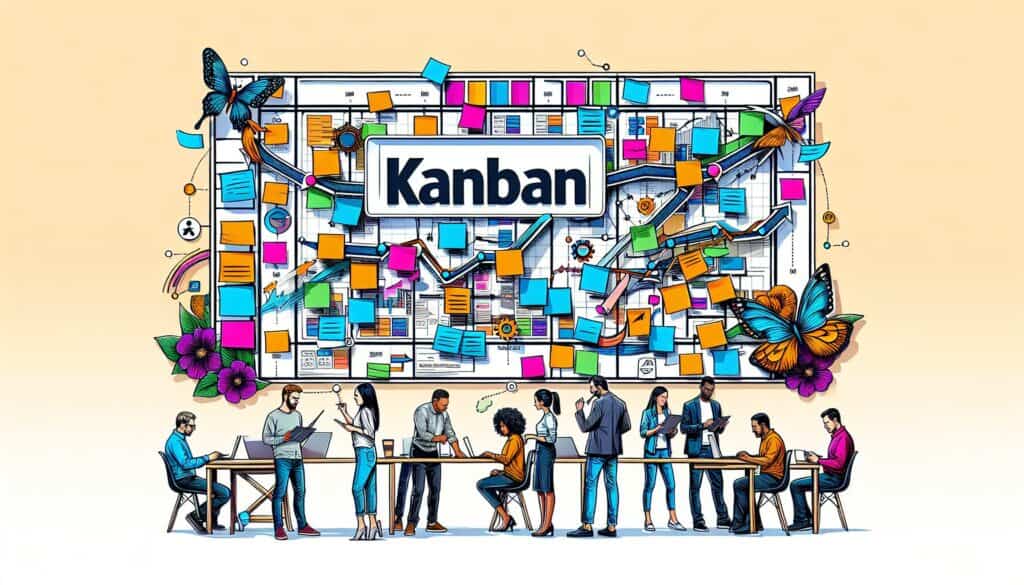طريقة مرئية لإدارة سير العمل مصممة لمساعدة فرق العمل على تصور عملهم، والحد من العمل الجاري (WIP)، وزيادة الكفاءة (أو التدفق).
- المنهجيات: العملاء والتسويق, الأفكار, تصميم المنتج
كانبان

كانبان
- المنهجية الرشيقة, التحسين المستمر, كانبان, التصنيع اللين, تحسين العمليات, إدارة المشاريع, العمل الجماعي, تخطيط مسار القيمة
الهدف:
كيفية استخدامه:
- يتم تمثيل عناصر العمل ببطاقات على كانبان اللوحة المقسمة إلى أعمدة تمثل مراحل سير العمل. تقوم الفرق بسحب العمل من مرحلة إلى المرحلة التالية حسب ما تسمح به السعة، مع وجود حدود واضحة للمشاريع الجاهزة لكل مرحلة لمنع الاختناقات.
الايجابيات
- يحسن من وضوح وشفافية سير العمل؛ يساعد على تحديد الاختناقات بسرعة؛ مرن وقابل للتكيف مع مختلف العمليات؛ يعزز التدفق المستمر ويقلل من فترات الإنجاز من خلال الحد من المخزون المُستعمل.
سلبيات
- لا يوفر بطبيعته تقديرات زمنية للمهام؛ يمكن أن يكون أقل فعالية إذا لم يتم احترام حدود WIP أو إذا لم يتم تقسيم المهام بشكل مناسب؛ يتطلب انضباط الفريق والتزامه بالنظام.
الفئات:
- الأفكار, لين سيجما, تصنيع, تصميم المنتج, إدارة المشاريع
الأفضل لـ
- إدارة عمليات سير العمل وتحسينها، خاصة للفرق ذات التدفق المستمر للمهام أو في البيئات التشغيلية.
يتم استخدام منهجية كانبان بفعالية في مجموعة واسعة من الصناعات مثل تطوير البرمجيات والتصنيع والرعاية الصحية والخدمات اللوجستية، حيث تكون إدارة سير العمل المستمر أمرًا ضروريًا. على سبيل المثال، في فرق البرمجيات، يمكن للوحات كانبان أن تصور الميزات التي يتم تطويرها واختبارها ونشرها، مما يسمح بإجراء تعديلات في الوقت الفعلي بناءً على عبء عمل الفريق وأولوياته. في البيئات التشغيلية، مثل المصانع، يمكن أن تسهّل كانبان إدارة المخزون، مما يضمن تحرك الإمدادات بسلاسة عبر خطوط الإنتاج من خلال مواءمة العرض مع الطلب. يمكن تنفيذ هذه المنهجية خلال مراحل المشروع المختلفة، بدءًا من التصور الأولي وحتى الصيانة المستمرة، وهي مفيدة للفرق متعددة الوظائف بما في ذلك المصممين والمهندسين ومديري المنتجات الذين يحتاجون إلى التعاون بفعالية. وغالبًا ما يتضمن بدء نظام كانبان قادة الفرق أو مديري المشاريع الذين يضعون إطار العمل، بينما يشارك جميع أعضاء الفريق في تحديث اللوحة وإدارتها، مما يضمن بقاء العمل مرئيًا ومشاركة المسؤوليات. ومع وجود حدود محددة للعمل قيد الإنجاز، يشجع نهج كانبان الفرق على التركيز على إكمال المهام قبل تولي مهام جديدة، مما يقلل من مخاطر الحمل الزائد ويعزز التركيز على تقديم نتائج عالية الجودة. يمكن للمراجعات المنتظمة أن تحدد الاختناقات، مما يسمح بالتدخلات في الوقت المناسب التي تؤدي إلى تحسين العملية، مما يجعل كانبان أداة متعددة الاستخدامات لتعزيز إنتاجية الفريق والكفاءة التشغيلية.
الخطوات الرئيسية لهذه المنهجية
- تصور سير العمل من خلال إنشاء لوحة كانبان مع أعمدة لكل مرحلة من مراحل العملية.
- تحديد أنواع عناصر العمل وتعيين المهام للبطاقات التي تمثل هذه العناصر.
- قم بتعيين حدود واضحة للعمل الجاري (WIP) لكل عمود للتحكم في التدفق ومنع الاختناقات.
- تنفيذ نظام السحب حيث يقوم أعضاء الفريق بسحب المهام من العمود السابق حسب ما تسمح به السعة.
- مراقبة التدفق وإدارته من خلال تعديل حدود WIP وإجراء تحسينات على العملية بناءً على الأداء الملاحظ.
- قم بإجراء مراجعات منتظمة واجتماعات متابعة لمناقشة التقدم المحرز والتحديات والتعديلات المحتملة.
- إنشاء حلقات تغذية راجعة لتمكين التحسين المستمر، وتكييف اللوحة وسير العمل حسب الضرورة.
نصائح للمحترفين
- قم بإجراء مراجعات منتظمة بأثر رجعي لتنقيح حدود برنامج WIP والتأكد من أنها تعكس القدرة الفعلية للفريق وكفاءة سير العمل.
- استخدم مقاييس مثل وقت الدورة ووقت الإنجاز لإجراء تعديلات قائمة على البيانات على لوحة كانبان وتحسين الإنتاجية.
- قم بتنفيذ "ألواح السباحة" على لوحة كانبان لتصنيف عناصر العمل حسب النوع أو الأولوية أو دور الفريق، مما يعزز الرؤية والتركيز على المهام الهامة.
لقراءة عدة منهجيات ومقارنتها, نوصي باستخدام
> مستودع المنهجيات الشامل <
مع أكثر من 400 منهجية أخرى.
نرحب بتعليقاتكم على هذه المنهجية أو المعلومات الإضافية على قسم التعليقات أدناه ↓، وكذلك أي أفكار أو روابط متعلقة بالهندسة.
السياق التاريخي
1930
1940
1950
1950
1958
1960
1960
1930
1940
1949
1950
1950
1960
1960
1960
(إذا كان التاريخ غير معروف أو غير ذي صلة، على سبيل المثال "ميكانيكا الموائع"، يتم تقديم تقدير تقريبي لظهوره الملحوظ)















منشورات ذات صلة
محاكاة مونت كارلو
الاختبار المستند إلى النموذج
التحقق من النموذج
بحوث الأساليب المختلطة
تدقيق الأخطاء (بوكا يوك)
اختبار الملف الشخصي للمهمة